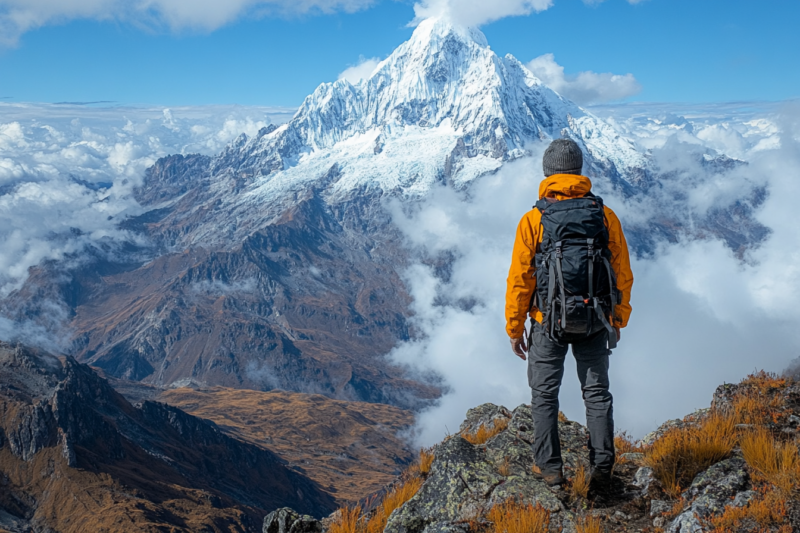
You’ve finally reached the high-altitude trails, surrounded by breathtaking vistas and the crisp mountain air. But instead of reveling in the beauty, you’re hit with pounding headaches, dizziness, or nausea. Altitude sickness, also known as acute mountain sickness (AMS), is a common condition that can affect even the fittest adventurers. It’s an unwelcome visitor that can turn what should be an unforgettable experience into a struggle.
Whether you’re trekking through the Andes, summiting Kilimanjaro, or skiing the Alps, understanding how to prevent and manage altitude sickness is essential. With the right preparation and strategies, you can minimize risks and keep your focus on the adventure.
Pre-Trip Health Check
Before embarking on your high-altitude adventure, it’s wise to have a medical evaluation. If you have pre-existing health conditions like heart or lung diseases, high altitude can exacerbate these issues. Ensure your doctor is aware of your plans so they can advise on any precautions or treatments.
What is Altitude Sickness?
Altitude sickness occurs when your body struggles to adapt to reduced oxygen levels at higher elevations. At altitudes above 8,000 feet (2,400 meters), air pressure decreases, reducing the oxygen available in each breath. Your body has to work harder to maintain normal function, which can trigger symptoms ranging from mild discomfort to life-threatening conditions.
Common Symptoms of Mild Altitude Sickness (AMS):
- Headache
- Nausea or vomiting
- Dizziness or lightheadedness
- Fatigue
- Shortness of breath
- Difficulty sleeping (insomnia)
Severe Symptoms (Seek Immediate Medical Attention):
- Confusion or inability to walk straight
- Persistent chest tightness or coughing
- Blue lips or fingernails (a sign of oxygen deprivation)
- Loss of consciousness
Recognizing symptoms early is critical to managing and preventing escalation. Left untreated, mild AMS can progress to more severe forms like:
- High Altitude Pulmonary Edema (HAPE): Fluid accumulates in the lungs, leading to severe shortness of breath, even at rest, persistent cough, and chest tightness.
- High Altitude Cerebral Edema (HACE): Swelling of the brain causes severe weakness, loss of coordination (ataxia), changes in mental status like confusion, hallucinations, or loss of consciousness.
Both require immediate medical attention, often necessitating descent.
How to Prevent Altitude Sickness
The key to preventing altitude sickness is preparation and pacing. Here are proven strategies to minimize the risk:
1. Ascend Gradually
- The golden rule of high-altitude travel is to give your body time to acclimatize.
- “Climb high, sleep low” is the mantra to follow: ascend during the day but return to a lower elevation for sleep.
- After reaching 8,000 feet, limit your daily sleeping elevation gain to no more than 1,000 feet (300 meters).
- Schedule acclimatization days into your itinerary, especially after significant altitude gains. For example, if you’re trekking to Everest Base Camp, plan for rest days at key points, such as Namche Bazaar (11,286 feet) or Dingboche (14,468 feet).
2. Stay Hydrated
- Dehydration exacerbates altitude sickness symptoms by reducing blood volume and oxygen transport.
- Drink plenty of water: Aim for at least 3–4 liters daily.
- Include electrolyte-rich beverages to maintain a healthy balance and avoid overhydration, which can lead to hyponatremia (low sodium levels).
- Pro Tip: Monitor the color of your urine—it should be light yellow, not dark.
3. Eat a High-Carb Diet
- Carbohydrates require less oxygen to metabolize than fats or proteins, making them an ideal energy source at altitude.
- Focus on high-carb foods such as pasta, rice, bread, and fruits.
- Eat small, frequent meals to maintain energy levels and combat nausea.
4. Avoid Alcohol and Tobacco
- Both alcohol and tobacco impair acclimatization by reducing oxygen uptake and dehydrating the body.
- Alcohol: Avoid drinking for at least 48 hours after arriving at altitude.
- Smoking: The carbon monoxide in cigarettes further reduces the oxygen-carrying capacity of your blood.
5. Consider Medication
- Medications can help prevent or reduce the severity of altitude sickness:
- Acetazolamide (Diamox): This common medication speeds up acclimatization by encouraging deeper breathing and increasing oxygen uptake. Start taking it 24–48 hours before ascending and continue for several days.
- Ibuprofen or Aspirin: These can alleviate altitude-induced headaches.
- Pro Tip: Always consult a healthcare provider before taking medication to ensure it’s appropriate for your health and itinerary.
6. Train at Higher Altitudes
- Pre-conditioning your body by spending time at moderate altitudes before a high-altitude trip can make a significant difference.
- If possible, spend a few days hiking or training at elevations between 5,000–8,000 feet.
- Use altitude training gear, like masks or chambers, simulating high-altitude conditions. Train several times a week for at least a month before your trip, gradually increasing the duration and intensity.
7. Monitor Oxygen Levels
- Tracking your body’s oxygen levels helps detect early signs of altitude sickness.
- Pulse Oximeters: Portable devices measure blood oxygen saturation, giving you a clear picture of how your body is adapting.
- Pro Tip: A reading below 90% at altitude may indicate a problem and warrant a rest day or descent.
Environmental Considerations
- Weather: High altitudes can have rapidly changing weather conditions. Cold, wind, and intense solar radiation can not only affect your body’s ability to acclimate but also exacerbate symptoms or delay recovery. Always check weather forecasts and prepare for sudden changes.
Cultural and Ethical Considerations
- Respect for Local Practices: When traveling in culturally rich high-altitude areas, it’s important to respect local customs and environmental practices. Many mountain regions are sacred; understanding and participating in local rituals or respecting no-litter policies can enhance your experience and show respect for the land and its people.
Travel Insurance
- Consider Insurance: High-altitude travel warrants travel insurance that covers medical evacuations or treatments for altitude sickness, especially in remote areas where medical facilities are not readily available.
Managing Altitude Sickness
Even with the best preparation, symptoms can occur. Recognizing and addressing them promptly is vital.
1. Stop and Rest
- At the first sign of symptoms, stop ascending and give your body time to adjust.
- Mild altitude sickness often improves with rest at the same elevation.
- Avoid strenuous activity, which can exacerbate symptoms.
2. Descend if Necessary
- If symptoms persist or worsen, descending to a lower altitude is the most effective treatment.
- Descend by 1,000–2,000 feet (300–600 meters) to relieve symptoms.
- For severe cases like HAPE or HACE, immediate descent is critical.
- Pro Tip: Even small descents can bring significant relief.
3. Increase Oxygen Intake
- Supplemental oxygen can provide immediate relief from symptoms.
- Portable Oxygen Systems: Small, lightweight devices can boost oxygen levels temporarily.
- Hyperbaric Chambers: In remote areas, portable hyperbaric chambers simulate lower altitudes, stabilizing severe cases.
4. Medicate Responsibly
- Use medications to manage symptoms, but only as directed:
- Acetazolamide (Diamox): Alleviates persistent but mild symptoms.
- Antiemetics: Help control nausea and vomiting.
5. Stay Warm
- Cold temperatures can exacerbate symptoms, especially circulation-related issues.
- Wear insulated layers and gloves to maintain your body temperature.
- Use a high-quality sleeping bag rated for the temperatures you expect.
Psychological Preparation
- Mental Readiness: High-altitude environments can be psychologically challenging. Techniques like mindfulness, meditation, or even psychological preparation through visualization or breathing exercises can help manage stress and anxiety.
A Lesson on Listening to Your Body
Imagine you’re trekking to Everest Base Camp, surrounded by towering peaks and vibrant prayer flags. You’ve trained for months, and your excitement is high. But after reaching 12,000 feet, a throbbing headache sets in, followed by nausea. Determined to keep pace with your itinerary, you push forward. By nightfall, you’re unable to sleep, and your symptoms worsen.
Here’s what should have happened: Recognize the early warning signs of altitude sickness. Take an extra acclimatization day to rest, hydrate, and allow your body to adjust. That pause could mean the difference between summiting successfully and turning back prematurely.
Altitude sickness is not a sign of weakness—it’s a natural response to reduced oxygen levels. Listening to your body can prevent a mild issue from escalating into a serious problem.
Essential Gear for High-Altitude Adventures
Having the right gear is crucial for preventing and managing altitude sickness:
- Hydration Bladders and Bottles: Staying hydrated is essential.
- Pulse Oximeters: Monitor your oxygen levels with precision.
- Portable Oxygen Systems: A must-have for extreme altitudes.
- Insulated Layers: Protect yourself from cold temperatures.
- First Aid Kits: Be prepared for altitude-related emergencies.
Aftercare
- Recovery Advice: After experiencing altitude sickness, recovery is vital. Ensure you rest, stay hydrated, eat nutritious foods, and if symptoms were severe, seek medical follow-up to ensure full recovery.
Alternative Remedies
- Herbal or Natural Treatments: Some cultures use natural remedies like coca leaves in South America to help with altitude sickness. While scientific evidence might be limited, these can be part of your strategy, but always with the disclaimer to consult healthcare professionals before use.
Conclusion
High-altitude adventures are among the most rewarding experiences an adventurer can undertake, offering unparalleled beauty and personal achievement. However, these journeys come with risks that require preparation, vigilance, and adaptability. By understanding how to prevent and manage altitude sickness, you can focus on what truly matters: enjoying the journey, embracing the challenge, and creating unforgettable memories.
Ready to conquer new heights? Check out gear recommendations and prepare for your adventure.


